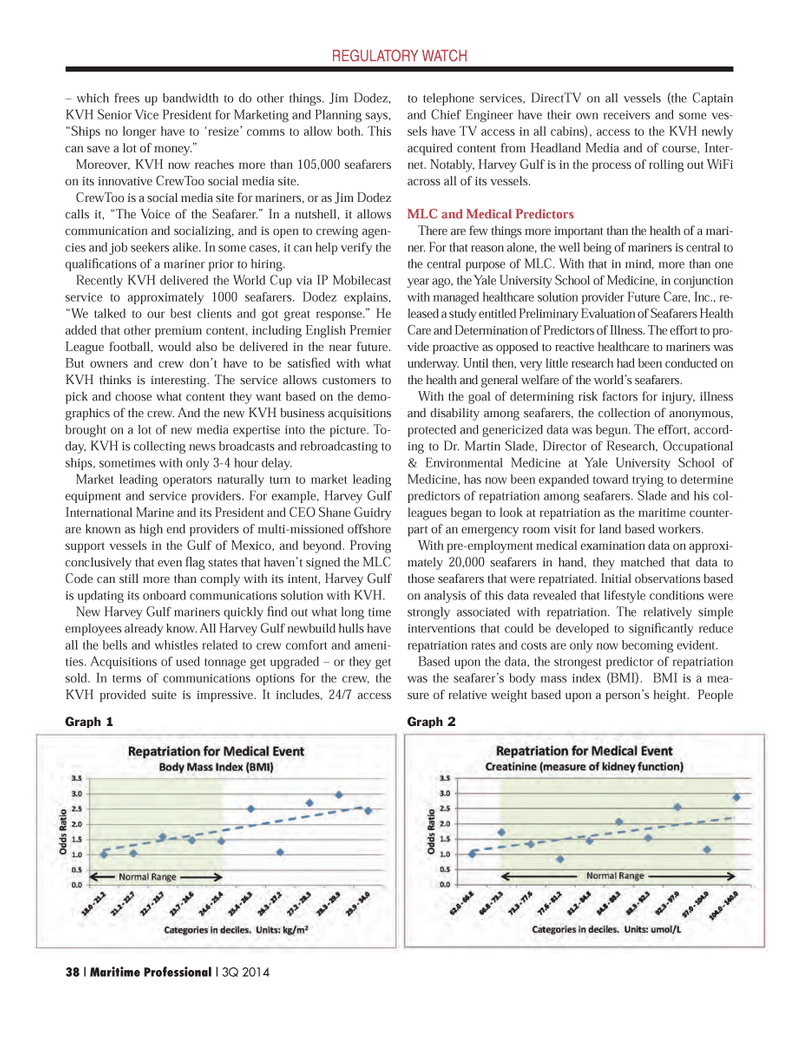
Page 38: of Maritime Logistics Professional Magazine (Q3 2014)
Power & Fuel Management
Read this page in Pdf, Flash or Html5 edition of Q3 2014 Maritime Logistics Professional Magazine
? which frees up bandwidth to do other things. Jim Dodez, KVH Senior Vice President for Marketing and Planning says, ?Ships no longer have to ?resize? comms to allow both. This can save a lot of money.? Moreover, KVH now reaches more than 105,000 seafarers on its innovative CrewToo social media site. CrewToo is a social media site for mariners, or as Jim Dodez calls it, ?The Voice of the Seafarer.? In a nutshell, it allows communication and socializing, and is open to crewing agen- cies and job seekers alike. In some cases, it can help verify the quali cations of a mariner prior to hiring. Recently KVH delivered the World Cup via IP Mobilecast service to approximately 1000 seafarers. Dodez explains, ?We talked to our best clients and got great response.? He added that other premium content, including English Premier League football, would also be delivered in the near future. But owners and crew don?t have to be satis ed with what KVH thinks is interesting. The service allows customers to pick and choose what content they want based on the demo- graphics of the crew. And the new KVH business acquisitions brought on a lot of new media expertise into the picture. To- day, KVH is collecting news broadcasts and rebroadcasting to ships, sometimes with only 3-4 hour delay. Market leading operators naturally turn to market leading equipment and service providers. For example, Harvey Gulf International Marine and its President and CEO Shane Guidry are known as high end providers of multi-missioned offshore support vessels in the Gulf of Mexico, and beyond. Proving conclusively that even ag states that haven?t signed the MLC Code can still more than comply with its intent, Harvey Gulf is updating its onboard communications solution with KVH.New Harvey Gulf mariners quickly nd out what long time employees already know. All Harvey Gulf newbuild hulls have all the bells and whistles related to crew comfort and ameni- ties. Acquisitions of used tonnage get upgraded ? or they get sold. In terms of communications options for the crew, the KVH provided suite is impressive. It includes, 24/7 access to telephone services, DirectTV on all vessels (the Captain and Chief Engineer have their own receivers and some ves- sels have TV access in all cabins), access to the KVH newly acquired content from Headland Media and of course, Inter- net. Notably, Harvey Gulf is in the process of rolling out WiFi across all of its vessels. MLC and Medical Predictors There are few things more important than the health of a mari- ner. For that reason alone, the well being of mariners is central to the central purpose of MLC. With that in mind, more than one year ago, the Yale University School of Medicine, in conjunction with managed healthcare solution provider Future Care, Inc., re- leased a study entitled Preliminary Evaluation of Seafarers Health Care and Determination of Predictors of Illness. The effort to pro- vide proactive as opposed to reactive healthcare to mariners was underway. Until then, very little research had been conducted on the health and general welfare of the world?s seafarers. With the goal of determining risk factors for injury, illness and disability among seafarers, the collection of anonymous, protected and genericized data was begun. The effort, accord- ing to Dr. Martin Slade, Director of Research, Occupational & Environmental Medicine at Yale University School of Medicine, has now been expanded toward trying to determine predictors of repatriation among seafarers. Slade and his col- leagues began to look at repatriation as the maritime counter- part of an emergency room visit for land based workers. With pre-employment medical examination data on approxi- mately 20,000 seafarers in hand, they matched that data to those seafarers that were repatriated. Initial observations based on analysis of this data revealed that lifestyle conditions were strongly associated with repatriation. The relatively simple interventions that could be developed to signi cantly reduce repatriation rates and costs are only now becoming evident. Based upon the data, the strongest predictor of repatriation was the seafarer?s body mass index (BMI). BMI is a mea- sure of relative weight based upon a person?s height. People REGULATORY WATCH Graph 1Graph 238 | Maritime Professional | 3Q 201434-49 Q3 MP2014.indd 3834-49 Q3 MP2014.indd 388/13/2014 3:07:56 PM8/13/2014 3:07:56 PM

 37
37

 39
39
